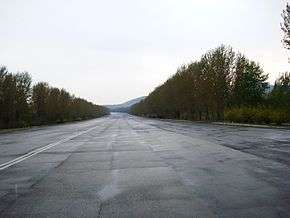Youth Hero Motorway
The Youth Hero Motorway (Korean: 청년영웅도로; Hanja: 青年英雄道路), also known as the Pyongyang–Nampo Motorway, is a 46.3-kilometre-long expressway (28.8 mi) in North Korea that connects the cities of Pyongyang, the capital of the country, and Nampo, a city on the coast of Korea Bay in South Pyongan Province. Construction began in November 1998, and the expressway opened in October 2000.[1] It is classified as a level 1 roadway.[2]
| |
|---|---|
| 청년영웅도로 | |
| Pyongyang–Nampo Motorway | |
 | |
| Route information | |
| Length | 46.3 km[1] (28.8 mi) |
| Existed | October 2000–present |
| Major junctions | |
| North end | Kwangbok Street, Mangyongdae-guyok, Pyongyang[1] |
| South end | Youth Bridge, Hanggu-guyok, Nampo, South Pyongan Province[1] |
| Highway system | |
According to the Korean Central News Agency, the motorway is so named for the youth that built the road. The project involved carrying 14 million cubic metres of earth and included over 80 irrigation structures, 50 bridges, and over 3 million cubic metres of asphalt.[3]
In the event of an armed conflict, the highway serves a defense purpose, allowing troops from the 107th and 108th Tank Divisions of the Korean People's Army to block highway access to Pyongyang.[4]
References
- Sharpe, M. E. (2003). North Korea Handbook. Yonhap News Agency. pp. 396–397.
- Melvin, Curtis (25 June 2009). "North Korea Uncovered - (Google Earth) - KMZ file". North Korean Economy Watch.
- "Pyongyang-Nampo Motorway Completed". Korean Central News Agency. 13 October 2000. Retrieved 14 June 2013.
- Madden, Michael (August 3, 2018). "Much Ado About Kangson". Henry L. Stimson Center. Archived from the original on August 3, 2018.
The Pyongyang-Nampo Highway is a key southern defense route for the Pyongyang Defense Command and III Army Corps. In the event of a domestic or foreign attack (from the South) on the DPRK, the 107th and 108th Tank Divisions deploy on the highway to cut off access routes into Pyongyang.
.svg.png)